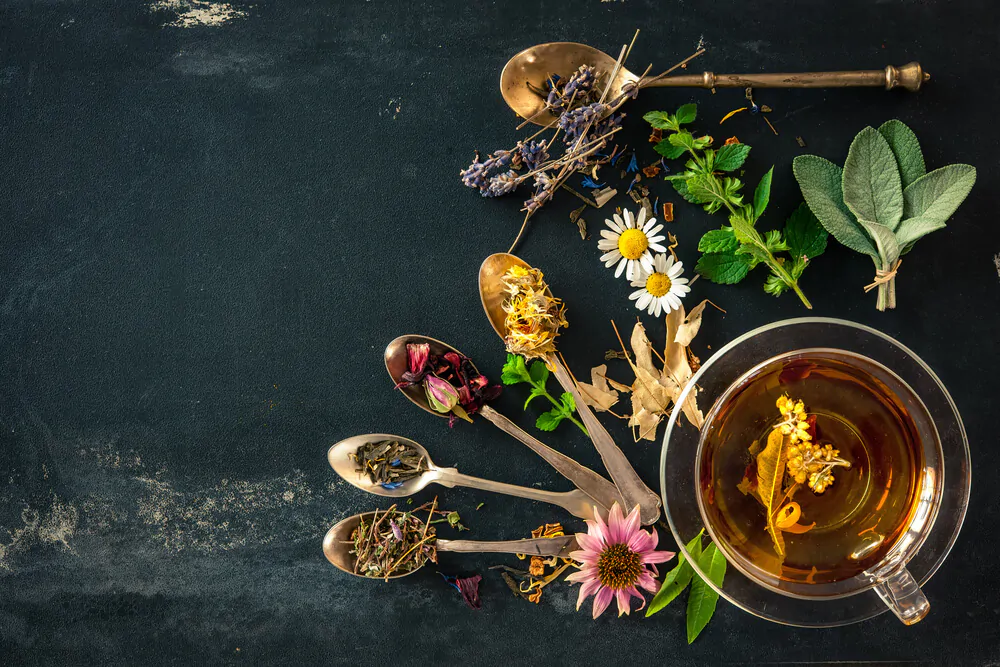Learning tea terminology will help you describe the tea you’re drinking with more clarity and confidence. Read and take a look at these words for tea lovers.

Whether you’re a newbie to the tea-drinking world or a seasoned tea connoisseur, adding some tea terminology to your vocabulary bank will help you become a more knowledgeable tea lover.
To get you started, I took some time this week to put together this general tea glossary for you. So, while your tea steeps, you can gloss over these words for tea lovers.
5 Words That Describe Taste
When tea lovers describe the tea they drink, they use very specific terms. As is the case with coffee drinks, tea is described according to its flavors, aromas, and body. To make you sound like a tea connoisseur, here are a few words you can take note of.
1. Aroma
Also called the nose or fragrance, aroma refers to how tea smells. A complex aroma is often called a “bouquet.”
2. Body
The body describes how a tea drink feels in your mouth. You can use words such as “light,” “medium,” or “full” to describe the substance of tea.
3. Flavor
Flavor is a combination of aroma and taste. I.e., flavor describes the overall impression a tea beverage imparts.
4. Finish
This is the lingering taste that’s left on your tongue after ingesting tea.
5. Astringency
Caused by the tannins in tea, astringency refers to that dry, puckering sensation you get after sipping tea.
4 Words That Describe Grades of Tea

Tea leaf grading is a process through which the quality of tea leaves is evaluated. The grading is largely based on two factors: the size of individual leaves, which determines whether they may fall through the screens of meshes; and the wholeness of the leaves. Broken leaves are graded lower than whole leaves.
Top-quality teas, however, are made from leaf buds. Pekoe tea grades, which are used to evaluate Western and South Asian teas, are classified into different qualities, which are determined according to the number of adjacent leaves that are picked together with the tea buds.
6. Pekoe (P)
This grade is used to describe basic, medium-grade black tea that contains whole leaves. Pekoe grade generally refers to the third and fourth leaf sets on a branch.
7. Orange Pekoe (OP)
Orange Pekoe is a higher grade of tea than Pekoe since it is made from the first two leaves from the tip.
8. Flowery Orange Pekoe (FOP)
This grading refers to Orange Pekoe grade tea that includes some leaf buds.
9. Broken (B)
When a “B” is added in front of any grade, it’s an indication that the leaves are no longer whole, but rather broken.
5 Words That Describe Types of Tea
Most teas are derived from the Camellia sinensis plant. Such varieties include black tea, white tea, green tea, and Oolong tea. However, some teas are made from herbs or other species of plants, such as herbal teas and rooibos tea.
10. Black tea
These types of teas are withered, rolled, and fully oxidized, after which they are fired in ovens. This process results in teas with full-bodied and malty flavors. Well-known black tea-producing regions include Assam, Darjeeling, and Sri Lanka. Black teas are often drunk with milk and sugar.
11. Green tea
As opposed to black teas, green teas are unoxidized, resulting in a tea with lower caffeine levels. To create green tea, the leaves of the Camellia sinensis plant are harvested and then immediately heat-treated to prevent oxidation from kicking in. These teas have earthy and grassy flavors.
12. White tea
White teas are the least processed and also among the rarest in the world. These teas are often made from the buds before they open to form full leaves. However, some white teas, such as White Peony, are made from unfurled tea leaves. White teas receive minimal amounts of oxidation and have floral, fruity, and delicate flavors.
13. Oolong tea
These teas are semi-oxidized, so they fall somewhere between green and black teas. To make Oolong teas, the leaves of the Camellia sinensis plant are bruised by tossing them in large bamboo baskets to start the oxidation process.
The length of the oxidation process varies depending on the type of Oolong, resulting in teas that can range from light and fragrant to dark and full-bodied.
14. Herbal tea
As opposed to the other teas on this list, herbal teas are not made from the leaves of the Camellia sinensis plant. Rather, they are made from dried flowers, herbs, and fruits. These teas are completely free from caffeine and impart delicate, fruity, and sweet flavors.
A Few Extra Words for Tea Lovers

Here are a few general terms you may come across when you’re reading about tea or chatting to another tea lover:
15. Oxidation
When you’re reading up about tea types, you may come across the word “oxidized.” Some teas are oxidized while others are not.
Oxidation refers to the process where leaves are withered or bruised, which allows for enzymes to interact with air and oxidize. This changes the chemical compounds and color of the leaves.
16. Gunpowder
Gunpowder is a type of green tea. The tea was named “gunpowder” because the tea leaves are rolled into tiny pellets before they are dried.
17. Art tea
Art tea has a strong visual appeal in that the tea buds of the tea open up to reveal beautiful flowers inside when you place them in hot water.
18. Matcha
Matcha is a powdered green tea that is made from plants that are grown in the shade 20 to 30 days before they are harvested. The lack of direct sunlight increases chlorophyll production, which gives the plant a darker green color and increases its antioxidant properties.
19. Withering
Once tea leaves are plucked they start to lose moisture. This is referred to as the withering process. Some teas, such as First Flush Darjeeling, are withered for a long time since doing so results in a brisker tea.
A Final Word on Words for Tea Lovers
Adding some tea terminology to your vocabulary bank will help you to describe the teas you drink with more knowledge and clarity. In addition, understanding more about different gradings and types of tea will also add to your enjoyment of tea-making and tea-drinking processes.
FAQs About Words for Tea Lovers
What is Chai Tea?
Chai is the Indian word for “tea.” This means that when we say “chai tea” we are actually saying “tea tea.” In India, tea is typically prepared with the following components: black tea, spices, sugar, and milk.
Does Tea Contain Caffeine?
Yes, tea drinks do contain caffeine. An 8-ounce cup of black tea contains approximately 47 mg of caffeine, while the same cup of green tea provides roughly 28 mg of caffeine. White tea contains the least caffeine, with a cup providing roughly 6 mg of caffeine.
